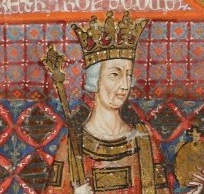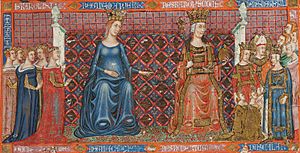Charles II of Naples facts for kids
Quick facts for kids Charles II |
|
|---|---|

King Charles II from the Bible of Naples, c. 1340
|
|
| King of Naples Count of Provence and Forcalquier |
|
| Reign | 7 January 1285 – 6 May 1309 |
| Coronation | 29 May 1289 |
| Predecessor | Charles I |
| Successor | Robert |
| Count of Anjou and Maine | |
| Reign | 7 January 1285 – 16 August 1290 |
| Predecessor | Charles I |
| Successor | Margaret & Charles III |
| Prince of Achaea | |
| Reign | 7 January 1285 – 16 September 1289 |
| Predecessor | Charles I |
| Successor | Isabella and Florent |
| King of Albania | |
| Reign | 7 January 1285 – 13 August 1294 |
| Predecessor | Charles I |
| Successor | Philip I, Prince of Taranto |
| Born | 1254 |
| Died | 5 May 1309 (aged 54–55) Naples, Kingdom of Naples |
| Spouse | Maria of Hungary |
| Issue More |
|
| House | Anjou-Naples |
| Father | Charles I of Naples |
| Mother | Beatrice of Provence |
Charles II, also known as Charles the Lame, was born in 1254 and died on May 5, 1309. He became King of Naples, Count of Provence, and Count of Forcalquier in 1285. He also held titles like Prince of Achaea and Count of Anjou and Maine. He was even called King of Albania for a time.
Charles was the son of Charles I of Anjou, a very powerful ruler in Europe. His mother was Beatrice of Provence. In 1272, his father made him the Prince of Salerno. Later, in 1279, he became a regent (someone who rules for a king) in Provence.
After an uprising called the Sicilian Vespers in 1282, the island of Sicily became a separate kingdom. Charles's father made him regent in the mainland part of their kingdom, which was called the Regno (later the Kingdom of Naples). Charles tried to make things better by getting rid of unpopular taxes. But he couldn't stop the Aragonese from taking over parts of his land. In 1284, he was captured in a sea battle near Naples. He was still a prisoner when his father died in 1285. The rest of his time as ruler was spent trying to end the war with Sicily and managing his kingdom.
Contents
Early Life and Family
Charles was born in 1254. He was the only son of Charles I of Anjou and Beatrice of Provence. This meant he would inherit a huge kingdom. His father ruled many lands, including Provence, Forcalquier, Anjou, Maine, and the Kingdom of Sicily. Charles I also claimed the Kingdom of Albania and parts of the Kingdom of Jerusalem. He also inherited Achaea in Greece.
In 1269, Charles's father arranged a special double marriage. Charles was to marry Maria, the daughter of Stephen V of Hungary. Charles's sister, Isabelle, would marry Maria's brother.
When Charles got very sick in 1271, his father prayed for him. After Charles recovered, his father went on a pilgrimage to thank God. In 1272, Charles was made a knight. His father also gave him the Principality of Salerno. This was a special title usually given to the future king.
Becoming a Regent
In 1279, Charles's father put him in charge of Provence. Charles also met with Peter III of Aragon, who was related to him. Peter III had taken over the Kingdom of Sicily from Charles's father. Peter was not friendly to Charles, even though they were family.
Charles's father and the Pope also planned to create a new kingdom called the Kingdom of Arles. This kingdom was meant for Charles's son, Charles Martel, when he married Rudolf's daughter. Charles was chosen to rule for his young son.
Life in the kingdom was tough because of high taxes. In 1282, a big riot called the Sicilian Vespers broke out in Palermo, Sicily. This rebellion ended Charles I's rule on the island. Peter III of Aragon arrived and was declared king of Sicily.
In 1283, Charles I appointed Charles and his cousin, Robert II, Count of Artois, to rule the mainland kingdom. Charles held a meeting where he made important changes. He got rid of unpopular taxes and confirmed the rights of noblemen and priests. He also reduced the common people's duties. These changes made it harder for his father to fight wars.

Charles also tried to make the local nobles happier by giving them important jobs. He even punished some officials who had collected taxes unfairly. But Charles didn't have much money for war. He had to borrow a lot from the Pope, other kings, and bankers. He used this money to build new ships. However, the Aragonese admiral, Roger of Lauria, defeated Charles's fleet. Lauria then blocked the Bay of Naples.
Captured and Released
The people of Naples wanted Charles to attack the Aragonese. Even though his father told him not to, Charles decided to attack. On June 5, 1284, he sailed to attack the Aragonese ships. But his fleet was defeated, and Charles was captured.
He was taken to Messina, where some people wanted him executed. But Constance of Sicily, Peter III's wife, saved him by putting him in prison.
Charles I died on January 7, 1285. Since Charles was still in prison, his kingdom was ruled by others. The Pope did not want Charles or his young son to rule right away. He said the kingdom would be ruled by regents on behalf of the Church.
The Pope also declared a crusade against Aragon. But the crusaders had to retreat. Charles was moved to Catalonia. Peter III died in November 1285. His sons, Alfonso III and James, took over his kingdoms.
Charles's sons asked Edward I of England to help free their father. Edward helped arrange a truce. Charles was willing to give up Sicily to James for his freedom. But the Pope didn't agree. After more talks, a new agreement was made in 1288. Charles would be released for a large sum of money. He also promised to help make peace between Aragon, France, and the Pope. As a guarantee, he sent his three sons and 60 noblemen as hostages. Charles was finally released and went to Paris to talk with the King of France.
Charles's Reign
Starting as King
In 1289, Pope Nicholas IV crowned Charles as king in Rieti. The Pope wanted Charles to keep fighting for Sicily. He even gave Charles money from Church taxes to help. The Pope also said Charles didn't have to keep the promises he made to get out of prison.
Charles, influenced by his advisors, wanted to create a kingdom that was purely Christian. He ordered the expulsion of Jews and Lombards from some of his lands. He accused them of charging too much interest on loans. He also forced many Jews in Southern Italy to convert to Christianity. He also brought the Inquisition to his kingdom.
Alfonso III of Aragon attacked Charles's kingdom, but Charles's forces, led by his son Charles Martel, defended it. Edward I of England urged Charles to stick to the peace treaty. Charles and Alfonso signed a two-year truce. To bring stability to Achaea, Charles arranged a marriage for Isabella of Villehardouin, the daughter of a former prince. He gave Achaea to her and her husband, Florent of Hainaut.
Working Towards Peace
Charles left Southern Italy to talk with King Philip IV of France. He even offered to go back to prison as he had promised, but no one came to arrest him. In 1290, Charles and Philip IV signed a treaty. Charles gave his daughter, Margaret, in marriage to Philip's brother, Charles of Valois. He also gave them Anjou and Maine as her dowry. In return, Charles of Valois promised to give up his claim to Aragon.
In 1291, a new treaty was signed that brought peace between Aragon, France, and Charles. Charles got back some lands from the French king. The Pope also agreed to the treaty because Alfonso of Aragon promised to lead a crusade to the Holy Land.
But Alfonso died unexpectedly. His brother, James, became king of Aragon. James didn't want to give up Sicily. Meanwhile, the Mamluks took over the last Christian strongholds in the Holy Land. Pope Nicholas IV asked for ideas on how to get the Holy Land back. Charles was the only king to respond.
After Pope Nicholas IV died, there was a long time without a Pope. Charles continued to talk with James of Aragon. An agreement was made in 1293. James agreed to give up Sicily for some money. Charles also helped the cardinals elect a new Pope, Peter of Morrone, who became Pope Celestine V. The new Pope gave Charles money to fight for Sicily. When Celestine V stepped down, Benedetto Caetani became Pope. He wanted to end the war to start a new crusade.
Peace at Last
Pope Boniface VIII confirmed the agreement between James and Charles in 1295. However, the people of Sicily refused this agreement. James of Aragon's brother, Frederick, was crowned king of Sicily. Frederick then attacked Charles's lands.
Charles tried to get Frederick to agree, but Frederick refused. The war continued on land and sea. Charles, with help from the Pope and others, couldn't conquer Sicily. His son, Philip, was even captured in a battle in 1299.
Finally, peace was made in 1302 with the Treaty of Caltabellotta. Charles gave up all his claims to Sicily. He also agreed to his daughter Eleanor marrying King Frederick. The Pope approved the treaty in 1303. Charles spent his last years peacefully in Naples, making the city better and more beautiful.
He died in Naples in May 1309. His son, Robert the Wise, became the next king.
Family
In 1270, Charles married Maria of Hungary. She was the daughter of Stephen V of Hungary. They had fourteen children:
- Charles Martel of Anjou (1271-1295), who was meant to be King of Hungary.
- Margaret (1272-1299), who became Countess of Anjou and Maine. She married Charles of Valois.
- Saint Louis of Toulouse (1274-1298), who became the Bishop of Toulouse.
- Robert the Wise (1276-1343), who became King of Naples.
- Philip I of Taranto (1278-1331/2), who was Prince of Achaea and Taranto.
- Blanche of Anjou (1280-1310), who married James II of Aragon.
- Raymond Berengar (1281-1307), who was Count of Provence.
- John (1283-after 1308), who was a priest.
- Tristan (1284-before 1288).
- Eleanor of Anjou (1289-1341), who married Frederick III of Sicily.
- Maria of Naples (1290-circa 1346), who married Sancho I of Majorca.
- Peter (1291-1315), who was Count of Gravina.
- John of Durazzo (1294-1336), who was Duke of Durazzo.
- Beatrice (1295-circa 1321), who married Azzo VIII d'Este.


